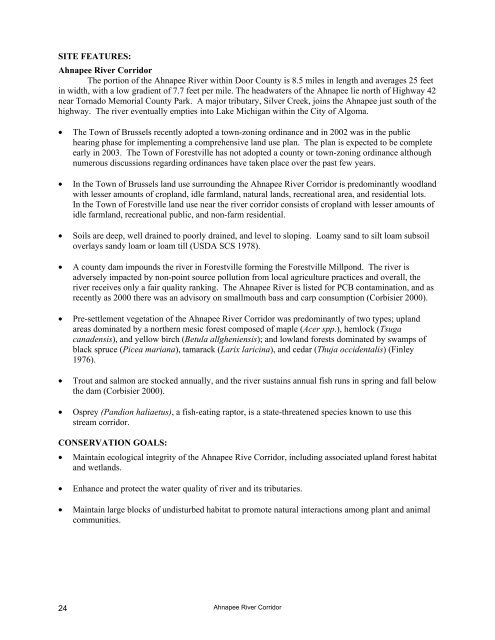Guide to Significant Wildlife Habitat - Door County Web Map
Guide to Significant Wildlife Habitat - Door County Web Map
Guide to Significant Wildlife Habitat - Door County Web Map
You also want an ePaper? Increase the reach of your titles
YUMPU automatically turns print PDFs into web optimized ePapers that Google loves.
SITE FEATURES:<br />
Ahnapee River Corridor<br />
The portion of the Ahnapee River within <strong>Door</strong> <strong>County</strong> is 8.5 miles in length and averages 25 feet<br />
in width, with a low gradient of 7.7 feet per mile. The headwaters of the Ahnapee lie north of Highway 42<br />
near Tornado Memorial <strong>County</strong> Park. A major tributary, Silver Creek, joins the Ahnapee just south of the<br />
highway. The river eventually empties in<strong>to</strong> Lake Michigan within the City of Algoma.<br />
• The Town of Brussels recently adopted a <strong>to</strong>wn-zoning ordinance and in 2002 was in the public<br />
hearing phase for implementing a comprehensive land use plan. The plan is expected <strong>to</strong> be complete<br />
early in 2003. The Town of Forestville has not adopted a county or <strong>to</strong>wn-zoning ordinance although<br />
numerous discussions regarding ordinances have taken place over the past few years.<br />
• In the Town of Brussels land use surrounding the Ahnapee River Corridor is predominantly woodland<br />
with lesser amounts of cropland, idle farmland, natural lands, recreational area, and residential lots.<br />
In the Town of Forestville land use near the river corridor consists of cropland with lesser amounts of<br />
idle farmland, recreational public, and non-farm residential.<br />
• Soils are deep, well drained <strong>to</strong> poorly drained, and level <strong>to</strong> sloping. Loamy sand <strong>to</strong> silt loam subsoil<br />
overlays sandy loam or loam till (USDA SCS 1978).<br />
• A county dam impounds the river in Forestville forming the Forestville Millpond. The river is<br />
adversely impacted by non-point source pollution from local agriculture practices and overall, the<br />
river receives only a fair quality ranking. The Ahnapee River is listed for PCB contamination, and as<br />
recently as 2000 there was an advisory on smallmouth bass and carp consumption (Corbisier 2000).<br />
• Pre-settlement vegetation of the Ahnapee River Corridor was predominantly of two types; upland<br />
areas dominated by a northern mesic forest composed of maple (Acer spp.), hemlock (Tsuga<br />
canadensis), and yellow birch (Betula allgheniensis); and lowland forests dominated by swamps of<br />
black spruce (Picea mariana), tamarack (Larix laricina), and cedar (Thuja occidentalis) (Finley<br />
1976).<br />
• Trout and salmon are s<strong>to</strong>cked annually, and the river sustains annual fish runs in spring and fall below<br />
the dam (Corbisier 2000).<br />
• Osprey (Pandion haliaetus), a fish-eating rap<strong>to</strong>r, is a state-threatened species known <strong>to</strong> use this<br />
stream corridor.<br />
CONSERVATION GOALS:<br />
• Maintain ecological integrity of the Ahnapee Rive Corridor, including associated upland forest habitat<br />
and wetlands.<br />
• Enhance and protect the water quality of river and its tributaries.<br />
• Maintain large blocks of undisturbed habitat <strong>to</strong> promote natural interactions among plant and animal<br />
communities.<br />
24<br />
Ahnapee River Corridor




![A Guide to the Control and Management of Invasive Phragmites [PDF]](https://img.yumpu.com/19126786/1/190x190/a-guide-to-the-control-and-management-of-invasive-phragmites-pdf.jpg?quality=85)







![Homeowner's Guide to Japanese Knotweed Control [PDF]](https://img.yumpu.com/19126766/1/190x245/homeowners-guide-to-japanese-knotweed-control-pdf.jpg?quality=85)




